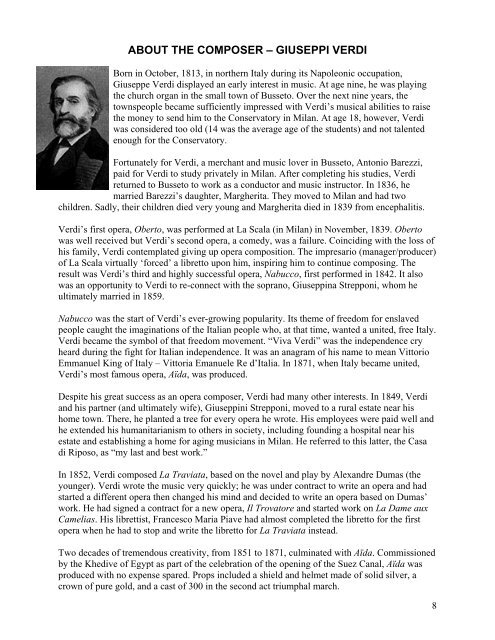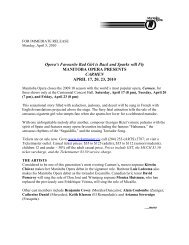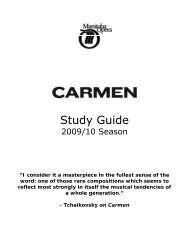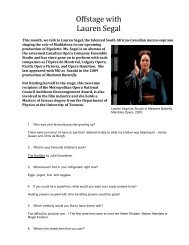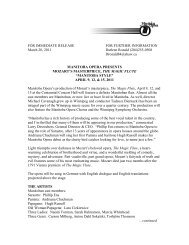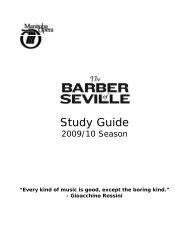La Traviata Study Guide - Manitoba Opera
La Traviata Study Guide - Manitoba Opera
La Traviata Study Guide - Manitoba Opera
You also want an ePaper? Increase the reach of your titles
YUMPU automatically turns print PDFs into web optimized ePapers that Google loves.
ABOUT THE COMPOSER – GIUSEPPI VERDI<br />
Born in October, 1813, in northern Italy during its Napoleonic occupation,<br />
Giuseppe Verdi displayed an early interest in music. At age nine, he was playing<br />
the church organ in the small town of Busseto. Over the next nine years, the<br />
townspeople became sufficiently impressed with Verdi’s musical abilities to raise<br />
the money to send him to the Conservatory in Milan. At age 18, however, Verdi<br />
was considered too old (14 was the average age of the students) and not talented<br />
enough for the Conservatory.<br />
Fortunately for Verdi, a merchant and music lover in Busseto, Antonio Barezzi,<br />
paid for Verdi to study privately in Milan. After completing his studies, Verdi<br />
returned to Busseto to work as a conductor and music instructor. In 1836, he<br />
married Barezzi’s daughter, Margherita. They moved to Milan and had two<br />
children. Sadly, their children died very young and Margherita died in 1839 from encephalitis.<br />
Verdi’s first opera, Oberto, was performed at <strong>La</strong> Scala (in Milan) in November, 1839. Oberto<br />
was well received but Verdi’s second opera, a comedy, was a failure. Coinciding with the loss of<br />
his family, Verdi contemplated giving up opera composition. The impresario (manager/producer)<br />
of <strong>La</strong> Scala virtually ‘forced’ a libretto upon him, inspiring him to continue composing. The<br />
result was Verdi’s third and highly successful opera, Nabucco, first performed in 1842. It also<br />
was an opportunity to Verdi to re-connect with the soprano, Giuseppina Strepponi, whom he<br />
ultimately married in 1859.<br />
Nabucco was the start of Verdi’s ever-growing popularity. Its theme of freedom for enslaved<br />
people caught the imaginations of the Italian people who, at that time, wanted a united, free Italy.<br />
Verdi became the symbol of that freedom movement. “Viva Verdi” was the independence cry<br />
heard during the fight for Italian independence. It was an anagram of his name to mean Vittorio<br />
Emmanuel King of Italy – Vittoria Emanuele Re d’Italia. In 1871, when Italy became united,<br />
Verdi’s most famous opera, Aïda, was produced.<br />
Despite his great success as an opera composer, Verdi had many other interests. In 1849, Verdi<br />
and his partner (and ultimately wife), Giuseppini Strepponi, moved to a rural estate near his<br />
home town. There, he planted a tree for every opera he wrote. His employees were paid well and<br />
he extended his humanitarianism to others in society, including founding a hospital near his<br />
estate and establishing a home for aging musicians in Milan. He referred to this latter, the Casa<br />
di Riposo, as “my last and best work.”<br />
In 1852, Verdi composed <strong>La</strong> <strong>Traviata</strong>, based on the novel and play by Alexandre Dumas (the<br />
younger). Verdi wrote the music very quickly; he was under contract to write an opera and had<br />
started a different opera then changed his mind and decided to write an opera based on Dumas’<br />
work. He had signed a contract for a new opera, Il Trovatore and started work on <strong>La</strong> Dame aux<br />
Camelias. His librettist, Francesco Maria Piave had almost completed the libretto for the first<br />
opera when he had to stop and write the libretto for <strong>La</strong> <strong>Traviata</strong> instead.<br />
Two decades of tremendous creativity, from 1851 to 1871, culminated with Aïda. Commissioned<br />
by the Khedive of Egypt as part of the celebration of the opening of the Suez Canal, Aïda was<br />
produced with no expense spared. Props included a shield and helmet made of solid silver, a<br />
crown of pure gold, and a cast of 300 in the second act triumphal march.<br />
8


